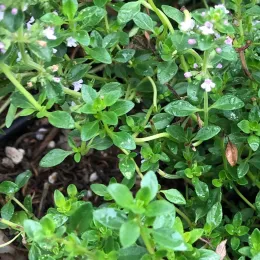
There are over three hundred varieties of thyme, but English thyme is the one most commonly grown for culinary use. French thyme has a similar, slightly milder taste. There are also thyme varieties with differently scented or colored leaves, such as lemon, golden lemon, and orange, as well as numerous ornamental thymes. Thyme is also attractive to bees and other beneficial insects. Thyme is a popular seasoning in omelettes, poultry dishes, stocks, stews, and salad dressings.
How to grow
Thyme gives best flavor in nutrient-poor soil
- Type: Perennial, evergreen, woody
- Light: Full sun
- Soil: Well drained
- Water: Low water. Do not overwater.
- Size: In general, 6–12" high, 6–12" wide. Space plants 12–24" apart, depending on variety
When to plant/propagate
- From seed: Direct seed after the last frost date in spring, or sow seeds indoors 6-8 weeks prior to the last frost date
- Transplants: Plant seedlings when danger of frost is past
- Cuttings & divisions: Propagate via cuttings in early summer
Harvesting
- For drying, harvest before flowering for best flavor
- Preserving and drying herbs
Pruning: Trim after flowering to promote new growth and prevent the plant from becoming woody
Indoors: Thyme can be grown as an indoor plant with 6 hours of bright light from a sunny window, or 12–16 hours of supplemental light provided by cool white fluorescent or LED lamps
More information
- Grow Herbs!, UCCE Master Gardeners of Sacramento County
Recommended Varieties for Santa Clara County*
See our list of Spring Garden Fair Herbs for varieties that we have found perform well here.
*Many other varieties may also do well here in Santa Clara County. This list is based on UC Master Gardener trials, taste tests, and feedback from local growers.
